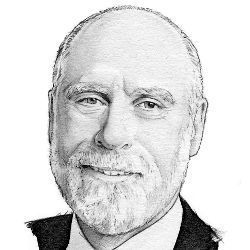
I’ve been thinking about "big ideas" recently and how powerful they can be. What strikes me is that so many of these ideas are so easily stated, such as "Cure Cancer" or "Put a man on the moon," but are really difficult to accomplish. Their simplicity hides enormous challenges, infinite details. At Google, the company began with a goal "to organize the world’s information and make it universally accessible and useful." As simply as this goal can be stated and, in some sense, understood, it also is a driver for an endless array of initiatives, intermediate goals, blind alleys, successes, and failures. One can adhere to this goal while motivating the development of machine translation, indexing and rank ordering searches of the World Wide Web, evolving massive datacenters and high capacity fiber networks and collaborative applications that allow concurrent editing of documents, presentations, and spreadsheets, to mention just a few examples.
One reason these easily stated big ideas are so powerful is that one can test whatever one is doing against the idea to see whether the work contributes to achieving the goal. If your goal is to make autonomous, self-driving vehicles, it’s easy to ask: "Is what I am doing contributing to this goal and if so, how?" This facet also helps multiple groups appreciate the work of others, assuming their work is understood to be relevant to the objective in hand. Big ideas are, in some ways, organizing principles that point in the direction of useful research, development, and engineering. Interestingly, these simply stated goals may also motivate the development of business models for sustainability, where the goal implies the need for continued, long-term maintenance and operation.
The Internet started with a simply stated goal of connecting any number and kind of packet switched networks. As complex as the Internet has become, this is still a driving factor in its evolution. The arrival of smartphones and high-speed, digital wireless communication, Wi-Fi, optical fiber networks, and many other networking technologies have been integrated into the global network of networks we have come to view as the Internet.
Artificial intelligence has been a long-sought goal in the computer science field, speculated about since the earliest days of computing. Alan Turing contemplated about this in 1950 with his famous paper on "Computing Machinery and Intelligence"a and Vannevar Bush hinted at this in his equally if not more famous paper "As We May Think."b Bush draws us into a vision that echoed and advanced with the work of J.C.R. Licklider and Douglas Engelbart, two giants in the fields of information processing and human/computer partnerships. With the notable successes of IBM’s Deep Blue,c IBM’s Watson,d and Google/DeepMind’s AlphaGo,e we can see examples of powerful specialization at work. DeepMind’s work appears to be generalizable to a number of board games and the multilayer neural networks from which DeepMind is fashioned seem able to learn how to play without specific programming. What is needed is exposure to many, many games and feedback as to success or failure. Whether such methods can be applied to what is called General Problem Solving isn’t entirely clear to me. The latter involves modeling, goal setting, hypothesis generation, experimental exploration, and testing—all of which remind me in some ways of the general scientific method.
As we explore the potential partnerships and collaborations between computing systems and their human users, many of us hope that we will accelerate progress in science, technology, applications, and economic conditions. Already we can see evidence that robotic factories are far more flexible than earlier special-purpose manufacturing systems. 3D printing, coupled with CAD/CAM and machine-aided design, may take us further along the path to what has sometimes been called "mass customization." If productivity increases, costs go down, making more things affordable. Jobs may well disappear but they will be replaced with new jobs. The conundrum is whether those displaced from older jobs can be equipped to carry out the new ones that are created. The big idea that comes to my mind is: "improve the well-being of every person on the planet."
Note in passing: A remarkable milestone for women filling all the leadership roles at ACM: President, Vice-President and Secretary/Treasurer. At the National Science Board a similar outcome: Chair, Vice-Chair, and Director of the National Science Foundation.



Join the Discussion (0)
Become a Member or Sign In to Post a Comment